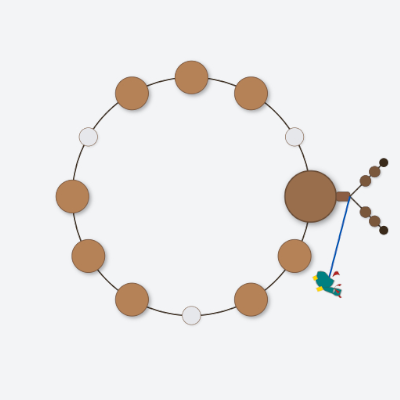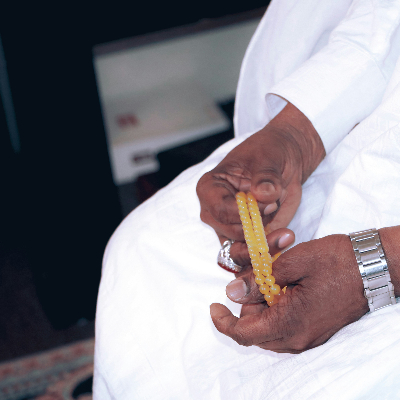
The Eight Major Components of a Traditional Prayer Bracelet
十一月 22, 2025 8 读
The Eight Major Components of a Traditional Prayer Bracelet: An Anatomy Lesson
When you first see one of our Agarwood bracelets, it may appear to be a simple circle of elegant beads. Yet beneath this simplicity lies a design with roots in a long and meaningful cultural tradition. In the world of 佛珠 (Fózhū, prayer beads) and 手串 (Shǒuchuàn, hand bracelet), every component is placed with intention, shaped by both craftsmanship and symbolism. Nothing is chosen by accident. Every bead, every knot, and every detail serves a purpose. It is similar to observing the inside of a finely made timepiece and discovering the many hidden elements working together with perfect harmony. If you are curious about what truly defines a remarkable bracelet, a closer look at the eight classic components found in this heritage will reveal the depth of artistry and cultural knowledge that inspires each Agarwood piece we create. Understanding these elements will help you appreciate not only the beauty and fragrance of Agarwood, but also the deeper stories that can be carried quietly around the wrist.
Although traditional 佛珠 (Fózhū, prayer beads) and 手串 (Shǒuchuàn, hand bracelet) designs may include several symbolic elements, our classic Grandawood bracelets are created with a focus on simplicity, elegance, and the natural beauty of Agarwood itself. Some pieces may include only a selection of these components, allowing the warm fragrance and unique grain to take centre stage. However, if the meaning behind the full set of eight elements speaks to you, we are delighted to tailor a design especially for your personal practice or style. Whether you prefer a pure and minimal look or a bracelet enriched with traditional details, your piece can reflect the level of symbolism and craftsmanship that feels most connected to you.
Getting to Know the Components
1. The Seed Beads (Zizhu)
These are the main beads that form the loop. They are the beads used for counting. The number can vary, such as twelve or eighteen on a bracelet, or one hundred and eight on a full mala. This number symbolises the overcoming of one hundred and eight kinds of human defilement. The uniformity and grain quality of these beads reveal the artisan’s skill and attention to detail.
Although this term comes from a Chinese cultural context, the concept exists in many spiritual traditions throughout the world. Each culture has its own name for these prayer counting beads:
- Buddhist cultures: Mala beads
- Christian (Catholic): Rosary beads
- Eastern Orthodox Christianity: Chotki or Prayer rope beads
- Islam: Misbaha or Tasbih beads
- Hinduism: Japa mala
- Sikhism: Simarna beads
- Bön or Tibetan tradition: Trengwa beads
- Japanese Buddhism: 念珠 (Nenju, meaning mindfulness beads)
Even though the names differ, the purpose remains consistent, which is to guide the hands and focus the mind during chanting, meditation, or prayer. This shared practice shows how universal the desire for mindfulness and spiritual connection is across many different cultures.
2. The Mother Bead (Muzhu)
This larger bead marks the beginning and end of each full recitation cycle. It represents the enlightenment and wisdom of the Buddha. It is the point where each full recitation cycle begins and ends, guiding the practitioner back to a place of awareness before continuing the next count. In many traditions influenced by Buddhism, this bead symbolises the ultimate wisdom or awakening that one seeks through practice.
Although the name 母珠 is rooted in a Chinese cultural heritage, this special guiding bead appears in other spiritual contexts as well:
- Tibetan and Himalayan malas: Called the Guru Bead, representing the teacher or source of guidance
- Hindu Japa mala: Also a Guru bead, not counted during recitation
- Catholic Rosary: The Crucifix or central connector serves as the prayer’s starting point
- Islamic Misbaha: Often a separating bead marking prayer divisions
In every case, this bead is treated with respect. It reminds the practitioner that the journey of prayer or meditation does not simply loop endlessly. There is always a moment to pause, return to mindfulness, and reconnect with intention before moving forward once again.
3. The Buddha Tower (Fota)

佛塔 (Fótǎ, Buddha Tower) is the smaller bead placed directly above the 母珠 (Mǔzhū, Mother Bead), and together they form what many traditions call the Guru Bead set. The 佛塔 symbolises the spiritual teacher or guide, and also the ultimate goal of cultivation, which is the realisation of one’s true nature and the completion of the spiritual path. In some cultural interpretations, its shape resembles a small pagoda or tower, reminding the practitioner to look upward, advance step by step, and remain devoted to growth. Similar guiding elements appear in other sacred bead systems, such as decorative markers above the Guru bead in Tibetan malas, or meaningful charms and symbols attached at the focal point of Catholic and Islamic prayer beads. Across cultures, this small component stands for direction, purpose, and the aspiration one holds while engaging in mindful practice.
4. The Spacer Beads (Gezhu)
隔珠 (Gézhū, Spacer Beads) are smaller beads placed among the main 子珠 (Zǐzhū, Seed Beads) to divide the bracelet into clear sections. Often made from contrasting materials or textures, they are designed to stand out under the fingertips so that the practitioner can recognise progress without needing to look. Their role is practical, helping mantra recitation feel more organised and easier to follow, especially during long periods of chanting or meditation.
Similar functional elements exist in many other prayer bead traditions as well. For example, Catholic Rosaries include marker beads at set intervals, and Islamic Misbaha often feature separating beads that indicate prayer milestones. Although the styles differ, the shared purpose remains the same. These special markers ensure a smooth, steady rhythm, allowing the mind to rest in the flow of the practice rather than counting each bead consciously.
5. The Disciple Beads (Dizizhu)

弟子珠 (Dìzǐzhū, Disciple Beads) are the small decorative beads found near the tassel area of the bracelet. Their purpose is supportive yet important. While the main 子珠 (Zǐzhū, Seed Beads) are used to count each mantra, the 弟子珠 provide a secondary counting system that helps the practitioner keep track of how many full rotations of the main loop have been completed. In longer periods of recitation, especially when focus is deep and the mind becomes calm, it is easy to lose track of how many cycles have passed. These additional beads serve as a gentle and reliable memory aid. Similar features can be found in other spiritual traditions as well, such as the small counters on Tibetan malas used to mark hundreds or thousands of repetitions. Regardless of cultural origin, the shared intention is to support dedicated practice while allowing the mind to remain peaceful and free from concern about numbers.
6. The Marker Retainer (Jizi Liu)
记子留 (Jìzǐ Liú, Marker Retainer) is the final knot or the small finishing bead positioned at the end of the 弟子珠 (Dìzǐzhū, Disciple Beads). Its role is simple yet essential. It ensures that the smaller beads remain secure on the cord and do not slip off during use or movement. In many forms of prayer beads across different cultures, there is always a final safeguarding element, whether it is a knot, a clasp, or a small bead, placed there to protect the integrity of the entire string. This practical finishing detail reflects the idea that every meaningful object, no matter how small or humble its component may seem, benefits from care and intention right to the very last piece.
Although the name 记子留 (Jìzǐ Liú, Marker Retainer) comes from one cultural tradition, the concept of a final securing element can be found throughout the world. Wherever prayer beads or meditation beads are used, there is always a need for something that protects the structure and keeps the beads safely on the cord. The form may differ, but the purpose remains universal.
Examples in other traditions include:
- Catholic Rosary: a metal clasp or connector holding the crucifix securely
- Orthodox Prayer Rope: a finishing knot tied with special intent and skill
- Islamic Misbaha or Tasbih: a terminal bead or tassel element securing the set
- Hindu and Sikh Mala: a final knot below the Guru bead, sealing the end of the strand
- Japanese 念珠 (Nenju): often finished with a tight cord knot beneath the tassels
In many of these traditions, the final securing piece is considered more than just a functional detail. It represents care, completeness, and the belief that even the final touch of a spiritual object should be carried out with respect. It is a reminder that everything meaningful deserves attention from the very beginning to the very end.
7. The String or Cord (Luosheng)
络绳 (Luòshéng, the String or Cord) is the foundation of the bracelet. It is the element that holds every bead together, forming the continuous circle that rests around the wrist. Sometimes the cord is elastic to suit daily wearing and comfort, while traditional full malas often use a strong fixed cord for long term durability.
Beyond its practical function, the 络绳 carries symbolic meaning. It represents the unbroken flow of spiritual practice, and the idea that every part of a person’s journey is connected. The circle shape formed by the cord also reflects the cycle of learning, devotion, and return, reminding the practitioner that there is no true beginning or end in the pursuit of wisdom.
This symbolism appears across many cultures. In Catholic Rosaries, Islamic Misbaha, Hindu Japa Mala, Sikh Simarna beads, and Japanese 念珠 (Nenju), the thread or cord always signifies unity. It is the unseen support that allows the practice of prayer or mantra to continue bead by bead. Although quietly hidden beneath the beauty of the beads themselves, the cord plays a role that is both essential and deeply meaningful.
8. The Fittings and Adornments (Peishi)

配饰 (Pèishì, Fittings and Adornments) are the decorative elements that accompany the beads, bringing personal meaning and visual character to the bracelet. These may include tassels, traditional knots, small metal accents, carved figures such as the 麒麟 (Qílín, an auspicious mythical creature), or other symbolic motifs chosen by the wearer.
While 配饰 enhance the appearance of the bracelet, their purpose is not purely aesthetic. In cultural traditions that inspire this design, each adornment can represent a wish or blessing. Common meanings include protection from negativity, guidance on one’s spiritual path, the attraction of good fortune, or the cultivation of peace in daily life.
Similar adornment practices appear in many spiritual bead systems. Catholic Rosaries may include medals or symbolic charms. Islamic Misbaha and Hindu malas often feature tassels that signify completion and unity. Japanese 念珠 (Nenju) may have cords or ornaments chosen with care to reflect the wearer’s personal devotion.
Regardless of the culture, such adornments allow the practitioner to form a deeper emotional bond with their bracelet. They transform the piece into something truly personal, filled with meaning beyond its physical form.
Are there just eight components in a bracelet?
Yes there are. Some could be quite fancy, the following is an example

Click here for more detail
Wrapping Up: The Value in the Detail
When you wear an Agarwood bracelet, you are not simply wearing a piece of fragrant wood. You are wearing a cultural artefact shaped by tradition, symbolism, and craftsmanship. Each component has a specific meaning and purpose. The natural calming fragrance of Agarwood also supports mindfulness throughout daily life.
留个言
张贴前管理员会先审核您的留言



